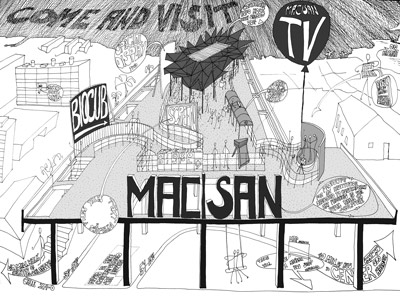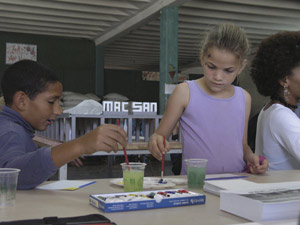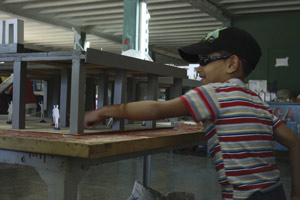Q & A with Candelario and Catherine Sicot on the MAC/SAN
The Artistic Laboratory of San Agustin(LASA) is making headlines againin this Eleventh Biennial. Following its foundation four years ago in this community located in the west of Havana, it’s been four years of hard work to deliver art in the daily life of its inhabitants. It has already grabbed some important recognition, such as the 2010 National Curatorship Award, handed by Cuba’s National Council of Arts. Today, LASA –project / work of Cuban artist Candelario Luaces co-run by French curator Aurélie Sampeur– presents MAC/SAN, its new artistic proposal. With this proposals, LASA staff, made up of an interdisciplinary and multinational collective of some fifteen or thirty people, not only finds another way to look deeply into the research started back in 2008 about the “San Agustinian” locality, but it also opens up the possibility of materializing one of the greatest aspirations of the Cuban contemporary art, as well as turning a territory located in the outskirts of the nation’s capital into one of its cultural centers.
 What do we mean when we speak about MAC/SAN?
What do we mean when we speak about MAC/SAN?
Candelario: MAC/SAN is a project that was born two years ago as a result of the residency of three artists, including myself. German Erik Göngrich and French-Swiss-British Stefan Shankland are my colleagues. During the Tenth Biennial, LASA had already conducted an exploration in the neighborhood through the senses, what we called Ensayos Publicos 1, 2, 3, 4 and 5. We definitely wanted to do something different, more utopian and, in a sense, more futurist. Then, the idea of organizing MAC/SAN or San Agustin’s Museum of Contemporary Art came up. The first thing I liked of the project was the possibility of making an old dream of our country come true: having a museum of contemporary art.
After the work had kicked off, we were joined by Catherine Sicot, French curator based in Canada. With her support, we have developed the conceptualization of what a museum of contemporary art in the 21st century can be. We didn’t have one in the 20th century, so we couldn’t think of having one today that followed models from the previous century: we had to adapt to the circumstances. So we started developing different theories on what was actually happening: did art need a museum or was the place the one needing it. Then, we invited other artists to support us with the project.
The first problem was finding a space where we could build the MAC/SAN, always keeping in mind that we didn’t want to have the traditional white cube with the same "funny" lights and the same boring pictures inside. Ours would be a new kind of institution, functional, to host or somehow nucleate artistic practices in the public space. But, how could the events taking place in the public space be in a museum without losing it vitality? We began working with this philosophy and finally found the right place: a building that belongs to ETECSA (Cuba’s Telecommunications Company, S.A.) and has been abandoned for fourteen years. It’s not even a building as such, but an architectonical structure made of steel and concrete, 60 x 25 x 8 m, with two levels built in the Giron system.[i]
In short, that’s the shape and idea of the project. The Eleventh Biennial of Havana was called; the Organizing Committee found it interesting and it was finally accepted.
How is the building going to be used?
Catherine: Generally, big events don’t take place within the museums and these buildings become spaces to store documentation on what happened outside. That’s the reason why MAC/SAN is projected to the exterior, because many of the artistic events will end up in the houses of the people. The building was conceived with an open shape, so it can host most of the practices presently taken as contemporary art and represent a meeting space among the people.
To deliver a more specific description on what’s going to happen, we could quote sculptor Stefan Shankland’s work. He is going to install the letters MAC/SAN in the second floor and the fact of putting them on an abandoned building already changes the concept of the place. The people will start asking: what’s the meaning of MAC/SAN? why is a sign placed on those ruins?, what’s going to happen there?. Shankland will manipulate the building to transform it into a sculpture, which has always been there, but nobody has seen it. All in all, we are going to attract the attention on one space to hold all sorts of events around it and question, from multiples perspectives, the limits among sculpture, architecture and daily life.
Candelario: My project in MAC/SAN is creating the first USB television in Cuba, a TV channel that circulates through these electronic devices. How? MAC/SAN TV behaves as a virus: as soon as you plug the "infested" pen drive in your PC, the information is automatically copied to C hard drive. It can be deleted from the hard drive, but not from the flash memory, not even by formatting it. Its program will invite students, journalists, artists and other professionals to produce audiovisual materials related to the territory of San Agustin and the presence of a museum of contemporary art; as well as providing a space to be transmitted.
MAC/SAN will also work as a catalyzer for the development of small local economies. BIOCUB is an example of this, Erik Göngrich’s proposal, professional architect. This German artist takes the abundance of mango trees in San Agustin as starting point. By using a technology created by Canadian non-governmental organization Malnutrition Matters, Göngrich will install a tunnel on the building where these mangos can be dried up with the sun, while other smaller driers are going to be placed in seven houses of the community, which have accepted to participate in the work. The product, bagged in small packages, is exquisite if consumed with yogurt, tea or any other infusions, and it will be sold for 1 cuc at MAC/SAN and other spaces in the city, linked to the Biennial. The proposal also includes a cafeteria where an infusion prepared with this dry mango is going to be sold. The sale is going to be managed by a freelancer we have hired with license and everything. The freelancer earns money, and we are interested in letting him understand that an artistic project is also an object to be sold.
Sun dryers, conceived by Göngrich as sculptures, were designed during his residence in San Agustin and their image is kind of related with the aesthetics of micro brigades and Giron construction system, very common in the zone. These sort of utilitarian sculptures are going to be donated by the artist after the event in order to decorate gardens in the neighborhood. Among the different items, there is a small electric fan powered by solar energy, and everything inside gets dried. It’s very healthy and green. But, how could those ideas reach the houses in the community?, how can the interest for art be developed from the economy, from the interest in the health of people?, how to break usual limits: because in some cases you are "hyper healthy" but you don’t know what art is; in other cases, you are an art expert, but you’re not healthy due to your lifestyle?, why not trying to find the balance, the harmony between art and life?
That’s what’s going to happen in the building. There will be several screens displaying audiovisual materials inspired in the different aspects of San Agustin’s life and history. All in all, the roof will become a meeting center for people, while the image of Shankland will be in the front wall and there will be many proposals downstairs, among them a stairs made of recycled material will be connecting both levels of the Museum.
 How are the people of San Agustin going to join MAC/SAN?
How are the people of San Agustin going to join MAC/SAN?
Candelario: Well, there are several projects, besides those previously mentioned, focused on this integration.For instance, a group of Colombian artists is going to create an ethno botanic map that, in fact, won’t be made at the Museum, but in the houses. Art will be knocking doors; the creators are going to work along with the neighbors. That’s one of the best examples, because art must go to the community, not the other way around. There is another work that comes closer to the people, it’s carried out by a Colombian actor and uses dance and theater to “invade” the streets. These sorts of proposals "turn the atmosphere on" so the museum space becomes a center concentrating the rest of the events.
However, “San Agustinians”, had already joined MAC/SANbefore launching it to the Biennial, since we conducted a survey San Agustin, including almost one thousand people, and we asked what they thought MAC/SAN would be and how. We have always kept in mind the results obtained when it comes to planning our work.
We are also going to launch two contests. One of them targets journalism students from the University of Havana and the winners gets a laptop. Each competitor has five minutes to explore the neighborhood of San Agustin and create an audiovisual capable of tackling a specific theme from the abstraction. We don’t want them to come and literally talk about the potholes in San Agustin, but do it through images like black holes, for example. In this case we, the people of LASA, will be the jury.
The other contest integrates the people in the community as such, and is specifically aimed at street sellers of vegetables and victuals. The prize is a super high-tech selling cart: it becomes a table to play domino, includes a cool box for water, space to keep the food warm, and features its own sounds and light... the dream of any of these freelancers. But they must have their license to participate, they must have paid the taxes (we wanted to play with this element they always try to shirk) and have correctly washed their products. Besides, they must answer some questions: why are you selling this? what’s the most demanded product?, why do you think people buy it so much?, how would you name the selling cart?, among others. The people would make up the jury, and we are in charge of handing the splendid prize, thus creating a sort of parameter or pattern in a so daily act as buying-selling victuals and vegetables, so, for the first time ever, the people get to find clean agricultural products. The idea is that this small artistic action end up been an important event in the kitchens of the community.
 MAC/SAN is going to be open during the Biennial… and what comes next?
MAC/SAN is going to be open during the Biennial… and what comes next?
Candelario: Continuing it, that’s what we want to achieve, but we must wait to the end of the Biennial and see what’s to be done later.
How could MAC/SAN continue when many of its proposals are linked to people that don’t live in Cuba?
Catherine: MAC/SAN came up from the exchange with people who don’t live in San Agustin, not even in Cuba. So, after the Biennial it will keep on getting energy from those exchanges. As I told you, it’s here but is very open, very big; it has no walls or borders. I can grow up and join the world, overflowing frontiers, not only out of San Agustin neighborhood, but the national geography.
For this to work, you must maintain that flow of people constantly entering and leaving...
Candelario: That’s right. And it can exist without the Biennial, because it was born without the Biennial. The question of MAC/SAN continuing or not after May depends on the human fatigue, instead of our wishes. There are tons of aspirations, desires and interest, the point is that the people running the show, Aurélie, me and now Catherine, must have the strength to keep it alive for a long time.
[i] Systemof prefabricated elements, created in the 1960s to massively build schools, hospitals and other social buildings. (N. from A.)
Related Publications

How Harumi Yamaguchi invented the modern woman in Japan
March 16, 2022












